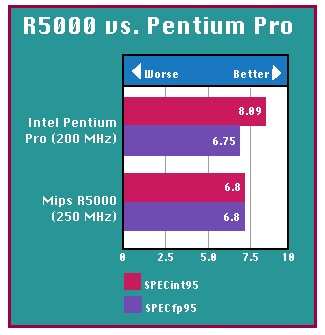| Programmers usually write their software to the metal,
but now chip engineers are bending the metal to fit the
software. The new R5000 microprocessor from Mips
Technologies (Mountain View, CA) is specially optimized
for the single-precision floating-point operations that
characterize today's 2-D and 3-D graphics. The result is a
powerful, affordable CPU that executes 400 million
floating-point operations per second (MFLOPS) and is
driving down the cost of high-end graphics performance. Silicon Graphics (Mountain View, CA), Mips' parent company, just announced three new models of its Indy desktop workstation based on early versions of the R5000. Prices range from $8495 to $13,995. SGI says the new systems handle 3-D graphics up to almost 100 percent faster than R4x00-based Indy workstations at the same price. The R5000 inherits several architectural innovations from Mips' top-of-the-line R8000 and R10000 processors. For example, the R5000 is a 64-bit CPU that supports the latest Mips IV instruction set, and its FPU has two-way superscalar pipelines. The R5000 has separate primary caches for instructions and data, and each cache is 32 KB in size, as well as two-way set-associative, just like the R10000. To cut corners, the R5000 doesn't have superscalar integer pipelines and can't execute instructions out of order. This greatly reduces the chip's complexity because it doesn't have to bother with scoreboarding and other tricky techniques to put instructions back in order again. In another cost-cutting measure, Mips eliminated the 128-bit secondary-cache bus found on the R4000 and R10000. Instead, the R5000 accesses its secondary cache over the general I/O bus, which is 64 bits wide. The payoff for the R5000's reduced complexity is a die that's exceptionally small (84 square millimeters on a .32-micron process) for a CPU of this capability. And a small die means less power consumption, lower manufacturing costs, and higher clock speeds. In March, Mips licensees NEC Electronics (Mountain View, CA) and Integrated Device Technology (Santa Clara, CA) were expected to begin shipping early versions of the R5000 clocked at 180 and 200 MHz. Prices range from $225 to $285, and the estimated performance at 200 MHz is a well-balanced 5.5 SPECint95 and 5.5 SPECfp95. Later this year, both vendors plan to ship 250-MHz versions that will deliver SPECmarks of about 6.8 (for both integer and floating-point performance) and still cost less than $300. Floating-point performance is the R5000's greatest strength. Mips says the R5000 can process more than 1.1 million 3-D graphics primitives per second, compared to about 670,000 graphics primitives for a 133-MHz PowerPC 604 and about 170,000 for a 133-MHz Pentium. Yet its overall performance is so well balanced that NEC and IDT expect to sell the R5000 to customers who will build the chip into a wide range of devices, including network routers, bridges, X Window terminals, laser printers, copiers, videogame machines, high-end PCs, and entry-level servers. MIPS R5000: What's NewR5000 vs. Pentium Pro Copyright 1994-1998 BYTE |